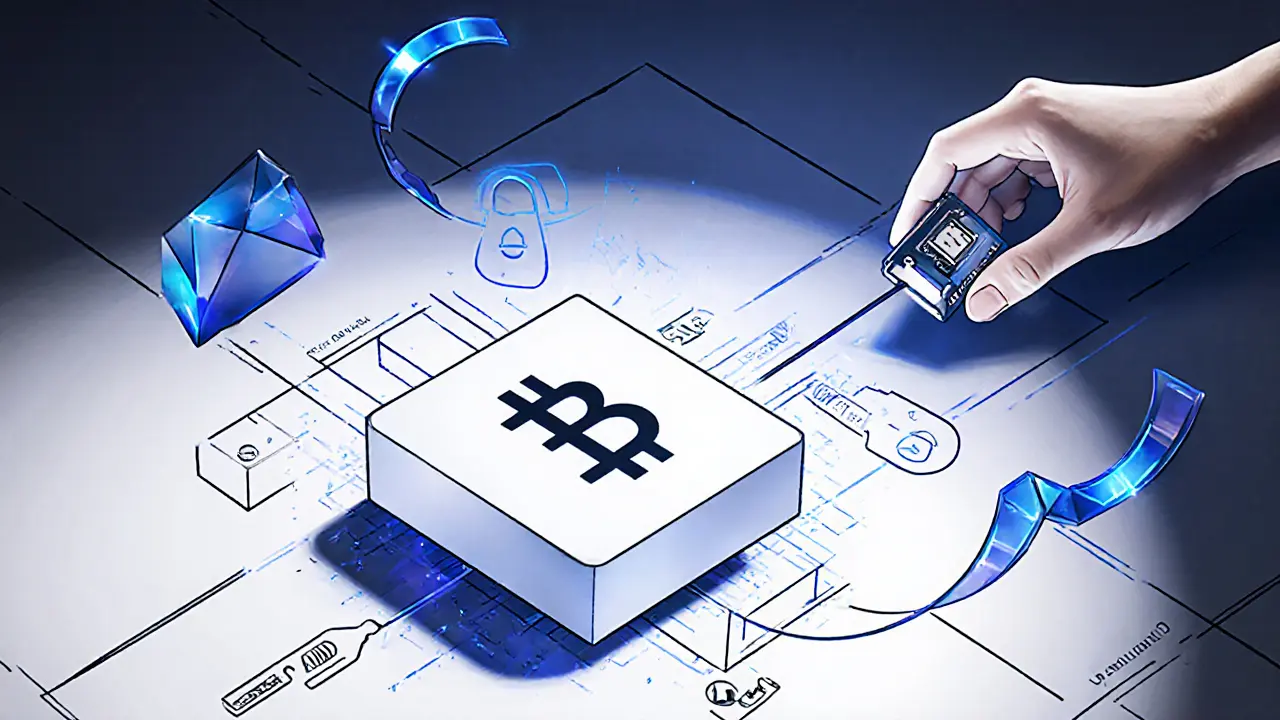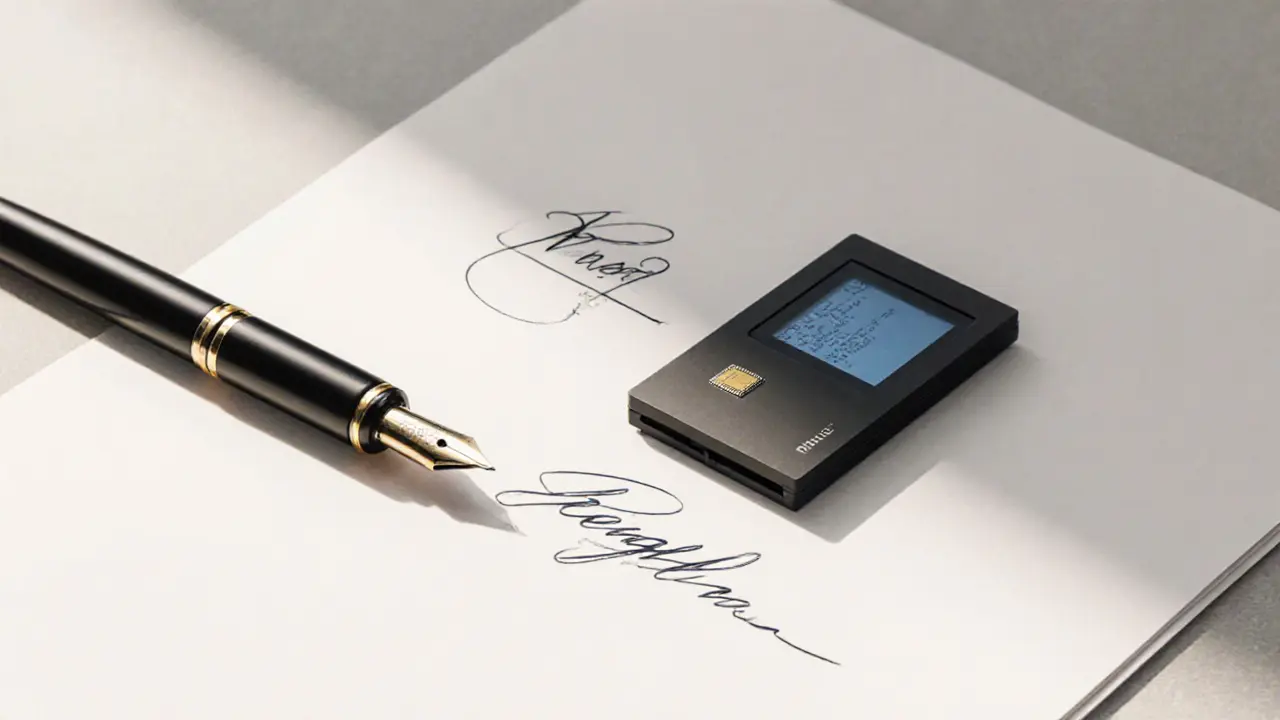Digital Signature Simulator
Simulate Digital Signature Process
Enter a message and choose a signature algorithm to see how digital signatures are created and verified.
Your message:
SHA-256 Hash: --
Simulated private key operation
Signature Value: --
Public Key (simulated):
When you hear the word "signature" in a crypto wallet, you probably picture a cryptographic proof rather than a pen‑stroke on paper. Understanding how Digital Signatures are cryptographic values that prove a message came from a specific private key differs from the way Traditional Signatures are handwritten marks made with a pen to indicate consent. This guide walks through the core mechanics, security trade‑offs, and real‑world blockchain uses so you can see why the crypto world has almost entirely left ink behind.
What a digital signature actually is
A digital signature is generated by taking a cryptographic hash of the transaction data and encrypting that hash with the signer’s private key. The resulting value can be verified by anyone who holds the matching public key. Because the private key never leaves the signer’s device, the signature proves both authorship and that the data hasn’t been altered.
Most public blockchains rely on ECDSA Elliptic Curve Digital Signature Algorithm, a lightweight scheme using elliptic‑curve math. Ethereum also supports EdDSA an Edwards‑curve variant that offers deterministic signatures. Newer upgrades like Bitcoin’s Taproot introduced Schnorr signatures a linear, non‑malleable scheme that enables signature aggregation, while some privacy‑focused chains experiment with BLS signatures Boneh‑Lynn‑Shacham signatures that allow whole‑block aggregation.
How a traditional handwritten signature works
A traditional signature is simply a physical imprint of a person’s handwriting. Its value comes from the unique way the individual applies pressure, speed, and style. Verification usually means a human expert comparing the signature on the document with a known sample. That process is inherently subjective and can be fooled by skilled forgers who replicate the visual traits.
Legal systems have accepted handwritten signatures for centuries because they provide a tangible, easily recognisable indication of consent. However, they offer no built‑in proof that the signer intended a specific digital transaction, nor do they protect the document from later tampering.
Creation and verification: step‑by‑step
- Digital signature creation
- Compute a cryptographic hash (e.g., SHA‑256) of the transaction.
- Encrypt the hash with the signer’s private key using the chosen algorithm (ECDSA, Schnorr, etc.).
- Attach the resulting signature bytes to the transaction payload.
- Digital verification
- Retrieve the signer’s public key from the blockchain or a certificate.
- Re‑hash the received transaction data.
- Decrypt the signature with the public key; if the decrypted hash matches the recomputed hash, the signature is valid.
- Traditional signature creation
- Sign the paper with a pen, producing a visual mark.
- The signer’s intent is inferred from the act of writing.
- Traditional verification
- Hand‑off the document to a forensic examiner.
- Compare the signature with known samples, looking for matching strokes, pressure patterns, and overall style.
Security comparison: why crypto users prefer digital signatures
Three key dimensions separate the two approaches:
- Authentication - Digital signatures rely on mathematically provable public‑key verification. Handwritten signatures depend on human visual assessment, which can be biased or simply mistaken.
- Non‑repudiation - Because only the holder of the private key can produce a valid signature, the signer cannot later deny involvement. Traditional signatures can be contested if a forged copy surfaces.
- Tamper resistance - Any alteration to a digitally signed transaction changes its hash, instantly breaking the signature. A paper document can be edited, scanned, and re‑signed without immediate detection.
In practice, these differences translate into real benefits for blockchain systems:
- Automated verification across thousands of nodes eliminates the need for human auditors.
- Multi‑signature schemes (e.g., 2‑of‑3) become trivial because each participant supplies a digital signature that can be aggregated.
- Signature aggregation (Schnorr, BLS) reduces transaction size, boosting network throughput by up to 40% in experimental Bitcoin tests.

Advanced signature schemes shaping the future
Schnorr signatures offer linearity, allowing multiple public keys to be combined into a single aggregated key are now the default for Bitcoin Taproot transactions. They enable “key aggregation” so the blockchain sees only one signature instead of many, hiding the number of signers and simplifying script analysis.
BLS signatures allow both key and signature aggregation across an entire block, cutting data size by about half are being prototyped in some proof‑of‑stake networks for faster consensus.
While RSA an older public‑key system based on integer factorisation remains secure, its large key sizes (2048‑bits and above) make it inefficient for on‑chain use. That’s why most modern chains favour elliptic‑curve‑based methods.
Implementation considerations - what you need to get started
Deploying digital signatures means setting up a Public Key Infrastructure (PKI) the framework for issuing, managing, and revoking digital certificates. Typical steps include:
- Generate a secure private/public key pair on a hardware wallet or HSM.
- Store the private key offline or in a sealed enclave to prevent leakage.
- Publish the public key on‑chain (e.g., as part of an address) or via a trusted certificate authority.
- Integrate a cryptographic library (such as libsecp256k1 for ECDSA) into your application code.
Traditional signatures, by contrast, require only pens and paper, but they also need trained handwriting analysts for verification - a costly and slow bottleneck.
Side‑by‑side comparison table
| Aspect | Digital Signatures | Traditional Signatures |
|---|---|---|
| Creation Method | Private‑key cryptographic operation on a data hash | Pen‑on‑paper gesture |
| Verification | Public‑key math, automated by software | Human visual comparison |
| Security Basis | Hard mathematical problems (ECDLP, discrete log) | Handwriting uniqueness, prone to forgery |
| Non‑repudiation | Strong - only private key holder can sign | Weak - signatures can be disputed |
| Tamper Evidence | Any change breaks the hash, invalidates signature | Alterations may go unnoticed without forensic analysis |
| Scalability | Thousands of signatures verified per second on a node | One‑by‑one human review |
| Typical Use Cases | Cryptocurrency transactions, smart‑contract validation, multi‑sig wallets | Legal contracts, paper‑based approvals |

Common pitfalls and how to avoid them
- Storing the private key insecurely - Use hardware wallets or encrypted keystores; never keep raw keys in plaintext files.
- Ignoring key revocation - If a key is compromised, publish a revocation transaction (or update the on‑chain address) immediately.
- Choosing the wrong algorithm - RSA is overkill for most blockchains; stick with ECDSA, EdDSA, Schnorr, or BLS depending on network support.
- Relying on outdated libraries - Keep cryptographic dependencies up‑to‑date to avoid known vulnerabilities.
Future outlook - post‑quantum signatures
Quantum computers could eventually break the elliptic‑curve problems that secure today’s digital signatures. Researchers are already standardising post‑quantum schemes like CRYSTALS‑Dilithium a lattice‑based signature algorithm resistant to quantum attacks and Falcon another lattice‑based scheme offering small signatures. While mainstream blockchains haven’t switched yet, upcoming upgrades may support hybrid signatures that combine ECDSA with a quantum‑safe fallback.
Bottom line
In crypto, a signature isn’t a doodle - it’s a mathematically provable statement that says, “I approved this transaction.” Traditional signatures still have a place for paper contracts, but they can’t match the automation, security, and scalability that digital signatures bring to decentralized networks.
Can I use a regular pen‑and‑paper signature to move cryptocurrency?
No. Crypto wallets require a cryptographic proof that only a private key can generate. A handwritten signature has no way to be verified by the network.
What’s the main advantage of Schnorr over ECDSA?
Schnorr signatures are linear, which lets multiple parties combine their keys into one aggregated signature. This reduces data size and hides the number of signers, something ECDSA can’t do efficiently.
Do I need a PKI to use digital signatures on a blockchain?
Most blockchains embed the public key directly in the address, so a full‑blown PKI isn’t required. However, for off‑chain integrations or enterprise use, a PKI helps manage certificates and revocation.
Are digital signatures legally binding?
In many jurisdictions, e‑signatures that meet standards like ESIGN (U.S.) or eIDAS (EU) are enforceable. The law usually looks at intent and the security of the signing process, not the visual appearance.
Will quantum computers make current crypto signatures obsolete?
Potentially, yes. That’s why the community is already testing post‑quantum algorithms like CRYSTALS‑Dilithium. Transition plans will likely involve hybrid signatures to keep funds safe during the switch.

